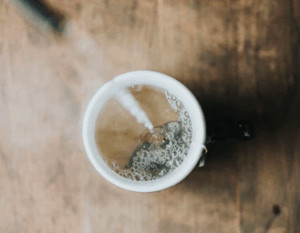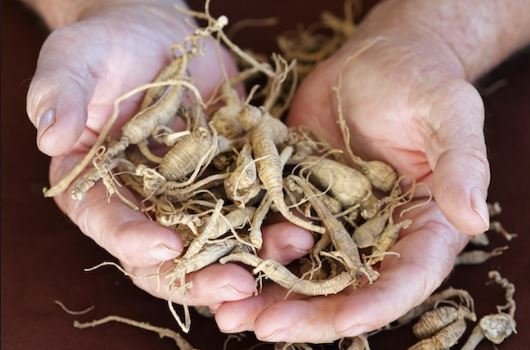What Is Ginseng? 5 Ginseng Health Benefits Plus Side Effects

- What Is Ginseng?
- Where Does Ginseng Grow?
- Ginseng Tea Explained
- 5 Ginseng Health Benefits Explained:
- 1. May Lower Blood Sugar
- 2. Has Anti-inflammatory and Antioxidant Effects
- 3. Can Treat Erectile Dysfunction
- 4. Could Have Benefits Against Cancer
- 5. May Limit Progression of Alzheimer's Disease
- Ginseng Side Effects Explained
- How To Find Ginseng?
- Why Is Ginseng So Expensive?
- Conclusion
Ginseng has been used in Traditional Chinese Medicine for centuries, so it’s no wonder it’s one of the most popular teas and remedies around. It may appear like a short plant that grows slowly, but don’t be fooled by it’s appearance, as it’s potential perks are vast. If you haven’t tried ginseng, you’re going to want to after you discover its wondrous health benefits. These advantages include: lowering blood pressure, improving cognitive function, and preventing cancer, just to name a few.
Ginseng is like a fine wine- the older it is, the better and more expensive. But it has to stay in the ground for a long time before receiving its positive benefits. Whether eaten raw, in a tea or as part of a soup, this magical plant has the potential to enhance your overall well-being and improve your quality of life. How exactly does this plant work, you may ask? Let’s get to the root of it.
What Is The Ginseng Plant?

American Ginseng Plant.
Ginseng is known for treating medical conditions and is considered an herbal medicine. The term Ginseng, derived from the Chinese term Ren Shen, is quite broad because it includes over twelve different species of plants. These plants belong to the Panax genus. There are different types of ginseng, but only two common ones. The first is the panax ginseng plant (aka panax ginseng c.a. meyer, Chinese ginseng, Asian ginseng, or Korean ginseng), which grows in Korea and northeastern China. The second is the panax quinquefolius, which is the American ginseng.
According to Chinese medicine, American ginseng is less stimulating than the Asian variety, but American ginseng still has its place in the market. The harvest of ginseng and ginseng products have become very economically and culturally important to American Indian tribes and a lot of communities in the United States.
Herbal extracts of the plant are made by drying its root and roots hairs. There are many plants that are referred to as ginseng, like Siberian ginseng and Brazilian ginseng, but they don’t actually contain the key necessary component, ginsenosides. Ginsenosides are presumed to be the active component of ginseng.
Where Does Ginseng Grow?
The American Ginseng plant typically grows in North America in deciduous forests, which lose their leaves every year. These forests range from the Midwest to Maine. Ginseng also grows in eastern Canada. The panax ginseng plant grows naturally, mainly in cooler regions in Asia, such as China, Korea, Bhutan and Siberia.
It is a highly valued plant with large fleshy roots. The natural ginseng roots are called white ginseng before any processing. Once the ginseng is processed through steaming and heating, the roots turn to a red color, making them red ginseng. The root is the most valuable in terms of medicinal needs, and it can be purchased whole, dried, or sliced. The leaves aren’t used as much, but they do have some value.
The root of ginseng is exported in large volumes. Most of the American ginseng that is harvested is exported to China. The trade of international ginseng began in the mid-1700’s, and even today, the harvest still has relevant economic and cultural influences on many areas in the U.S. and on American Indian tribes.
Ginseng Supplements And Capsules Explained

Tea is one of the most common ways to consume ginseng root.
We most often use ginseng in its raw form. Raw ginseng is thought to contain the highest amount of concentrated ginsenosides and other volatile essential oils. Yet a lot of people find the taste of raw ginseng to be quite harsh. Therefore, people have created a variety of supplements and forms of the root for use without having to use the root in its natural form. In this section, we’ll review ginseng supplements and capsules.
The two most common forms of the root are in tea form or capsule form. These are usually the most easily accessible forms of the extract. They’re easy to include in your daily diet. And while they may cost a little more than the root in its raw form, they’re often combined with a number of different healthy ingredients and beneficial supplements which increase the overall health benefits of the supplement.
The easiest way to get ginseng supplements or teas is to browse your local organic co-op or health food store. Ginseng is a very popular product in this sector and will most likely be easy to find (either in raw form or as a supplement). However, if you’d like to save money, I would recommend shopping online and buying in bulk. The cost will be significantly lower when you do so.
The added benefit of supplements or teas is that they have a considerably longer shelf life. This means that you can save a lot of money and be more consistent with the inclusion of the supplement in your diet, as a larger supply means that you have more available to use regularly. This increases the health benefits of using the supplements over time.
Ginseng Tea Explained

Ginseng tea.
Before you decide how to use ginseng in your diet, you should speak with your health care provider. They’ll want a list of all the other medications your taking to make sure there are no adverse effects, as with all herbal remedies. Even though ginseng is completely natural, systematic reviews of herbal supplements show how they are very powerful, which means they have the ability to harm you in addition to helping you. Specifically, it can interfere with other medications, such as Prozac, Cialis, Adderall, Caffeine, and warfarin. You also need to make sure that you’re ginseng was bought from a trustworthy source and not some sketchy website.
Using this plant can be quite simple. It can be consumed orally or it can be added to energy drinks, teas, beverages, and supplements. Ginseng is also a very common tea. The daily recommended dose of ginseng is the equivalent of 1-2 grams of dried root, which is about 400-1000 mg per day. You can use ginseng up to 3 months at a time. Never take more than the recommended dosage on the bottle. If you’re buying it in the powder form, you’re going to need a milligram scale. You can also buy a capsule making kit, which is very affordable.
5 Ginseng Health Benefits Explained:
1. May Lower Blood Sugar

Happy Woman.
Along with healthful diets and physical activity, ginseng can lower blood sugar levels in individuals with Type 2 Diabetes. Research suggests that the root extracts and elements in ginseng display anti-hyperglycemic actions, lower insulin resistance, and raise insulin production. These actions help regulate blood glucose levels for those with Type 2 Diabetes.
As American ginseng may allow your cells to respond to insulin more effectively, this helps maintain proper glucose levels in the blood. Specifically taking 3 grams of American ginseng orally up to 2 hours pre-meal may lower blood sugar levels, but larger doses are not more effective. Researchers believe that ginseng encompasses active chemicals called ginsenosides, which are responsible for this action.
However, it’s important to bear in mind that ginseng may interfere with other medications, such as warfarin (a blood thinner), so users should be sure to speak with their health care provider prior to use. Before drawing conclusive decisions, we need further clinical studies to verify these claims.
2. Has Anti-inflammatory and Antioxidant Effects

Ginseng root.
Among it’s many health benefits, ginseng is considered an adaptogen, a substance that helps fight off stressors of all kinds. Along with its anti-inflammatory properties, ginseng is seen to prevent inflammation and improve immune function. Studies suggest that ginseng effects cytokine levels and signalling proteins that are involved in inflammatory responses. Researchers believe that this response may come from ginsenosides, which target different areas of the immune system. With these anti-inflammatory properties, it can also reduce nerve inflammation and help with the recovery after a spinal cord injury. As an anti-inflammatory, it can help treat menstrual discomfort as well.
Red ginseng extract may also have an impact in treating atopic dermatitis, or eczema. According to research, the red ginseng extract lowers the inflammatory response and boosts antioxidant actions when placed in a test tube with the skin cells of people with eczema. We need further studies to prove if these results will occur in humans as well.
Studies suggest that Korean red ginseng can lower oxidative stress and improve antioxidant properties. In this study, old and young rats received korean red ginseng extract. The older rats given a diet that had korean red ginseng extract had significantly less oxidative damage.
In the American variety of ginseng, there are polysaccharides and oligopeptides. Similar to korean red ginseng, these are known to lower oxidative stress, enhance physical activity, fight fatigue, and generally boost your energy. It’s for these reasons that you commonly find ginseng in energy drinks.
3. Can Treat Erectile Dysfunction
Ginseng may be used as a treatment in men who are looking to boost their sexual performance. In a double-blind study analyzing the effectiveness of korean red ginseng in individuals with erectile dysfunction, it appears that those who took ginseng had improved performance.
Ginseng is also seen to have an effect on nitric oxide production, which relaxes the inner muscles of the blood vessels and causes the vessels to widen. As nitric oxide raises the blood flow and relaxes the muscles, men are better able to perform.
In addition, a systematic review analyzed randomized clinical studies of red ginseng as a treatment for erectile dysfunction. These studies suggested that there is evidence that red ginseng is an effective treatment. However, we need further studies before drawing conclusive results, .
4. Could Have Benefits Against Cancer
American ginseng may have a beneficial role in cancer patients. According to a study performed by Mayo Clinic, high levels of the ginseng herb given over the course of 2 months was seen to lower cancer-associated fatigue in patients, more than the effects of a placebo. Of these patients, 60% of them had breast cancer.
Cancer patients often experience fatigue, which stems from an increase in cytokines (substances involved in inflammation in the immune system). Fatigue also seems to result from poorly regulated amounts of cortisol, a stress hormone. Since ginseng contains an active ingredient, ginsenosides, it appears to lower cytokine levels associated with inflammation and assist in regulating normal cortisol levels. Although we need further research, these anti-inflammatory effects may improve the well-being of cancer patients.
5. May Limit Progression of Alzheimer’s Disease

Senior Couple Running.
In addition to the numerous potential health benefits of ginseng, it can also improve cognitive function and reduce the progression of Alzheimer’s Disease. Studies show that when ginseng is taken in addition to Alzheimer’s medications, it can improve cognitive deficits and mental performance. Two of the elements in ginseng, ginsenosides (ginseng saponins) and gintonin, may be the active compounds responsible for the improvements in Alzheimer’s patients.
Further studies suggest that taking ginseng supplements for more than 5 years can improve cognitive function later on in life. In a study with 3,918 participants, the researchers divided subjects based on how many years they took ginseng supplements, ranging from zero to more than 5 years. The results reveal that those who took ginseng for longer periods of time scored higher on the CERAD exam, a standardized measurement for assessing Alzheimer’s Disease.
Ginseng Side Effects Explained

Woman reading ginseng label.
Generally, the side effects of panax ginseng are mild because it is natural. However, even natural ingredients can cause complications when overdone or taken in combination with something else, such as phenelzine. Some people have reported that the side effects of ginseng included nervousness and insomnia. With both of those symptoms, it can be are hard to truly identify the source. You can be nervous about a lot of things in your life, which increases your insomnia, and a vicious cycle ensues.
I’m not trying to diminish these people’s feelings, but rather make a point that the side effects aren’t set in stone. The use of Ginseng isn’t one of these things that should be done forever. Take ginseng for 3 months at most, and then take a little break from it. It’s not recommended for children, or for women who are breastfeeding or pregnant because there’s a lack of evidence in its safety.
The most common short-term side effects of ginseng use are a headache, rapid heartbeat, high blood pressure, insomnia, breast tenderness, and vaginal bleeding. You should stop consuming ginseng if you have burning in your eyes, sore throat, fever, swelling in your tongue or face, or a painful skin rash. You may even notice blistering and peeling. If any of this happens, call your doctor immediately or head to the emergency room.
How To Find Ginseng?

Ginseng can be difficult to find.
You can add Ginseng to energy drinks and food, as you cannot find it naturally in foods. It’s important to buy ginseng from a reputable source, since around 50% of commercially sold ginseng contain less than the effective dose. You can also go look for ginseng in the wild for yourself, just make sure you aren’t trespassing.
Wild ginseng is regulated in only 19 states, and is forbidden in all other states. Those that allow it are: Alabama, Arkansas, Georgia, Illinois, Indiana, Iowa, Kentucky, Maryland, Minnesota, Missouri, New York, North Carolina, Ohio, Pennsylvania, Tennessee, Vermont, Virginia, West Virginia, and Wisconsin. These 19 states all have a harvesting season from September 1st to November 30th.
For a more convenient way to get ginseng, you can easily find it in a health food store, you just need to decide which species you want. You can also find Korean Kim’s 6 Years Red Ginseng, a pure red ginseng extract, easily on Amazon.
All varieties of ginseng provide different benefits. Korean ginseng is best for immune and psychological function, American ginseng is great for fighting fatigue, Siberian ginseng is for boosting energy and physical performance, and Indian ginseng can enhance cognitive abilities. Choose your supplement wisely!
Why Is Ginseng So Expensive?
There are two main reasons why ginseng is so expensive: it’s medicinal uses and it’s scarcity. Ginseng goes above and beyond all other herbs, with its many health benefits. It also takes a long time to make, which contributes to the high price.
The ginseng plant takes a lot of time to grow. By a lot of time, I mean anywhere from 5 to 10 years, so don’t hold your breath! It only grows in very specific weather conditions. The older the ginseng root, the more expensive it is. The mature roots are the ones with the maximum benefits. You can even find very expensive ginseng roots that are over 20-years-old. Ginseng has been declared endangered in many parts of the United States, which is why it’s not legal to harvest and sell it in most places. Understandably, something that’s been declared endangered is going to be expensive.
Conclusion
Ginseng is most impressive because of its ability to prevent aging, reduce stress, soothe inflammation, increase energy, and stimulate the mind. But in truth, it can do so much more! As I mentioned earlier, there is no scientific evidence to back the information on ginseng, but even doctors agree that it can do wonders and improve your quality of life. It’s expensive because it’s worth it. The prices for this gem of nature is only going to increase as time goes on.
Ginseng harvesters have to be careful with this plant because poachers may come looking for it. If you own a ginseng plantation, you don’t tell anyone. Keep this secret hush-hush. Most plantations have 24/7 surveillance for this very reason. Some even guard the plant with dogs or automatic weapons. As a consumer, you need to be careful not to buy fake ginseng. Yes, such a thing exists, just like fake diamonds exist. We know that there are seven wonders of the world, but apparently, there’s an eighth, and it’s ginseng.



